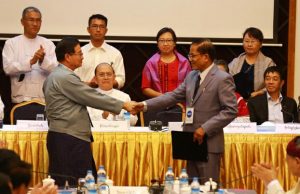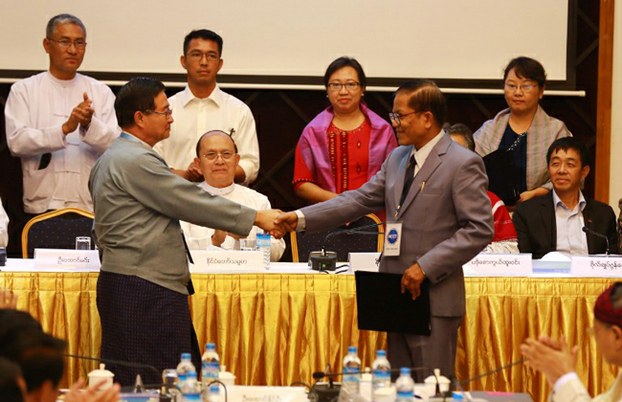The words democracy, freedom, federal and liberal have dominated Mon and Burmese political literature over the past twenty years in different ways and under different definitions based on the many social, cultural and political beliefs within the society at large. Mon and Burmese

writers have written on these subjects from a different angle but we are faraway from reaching the meaning of its origin unless the basic freedom of formulating ‘ideas’ is well respected among us.
The cases of the Mon nationalist agenda, propaganda and rhetoric have been written about widely in Mon and Burmese language journals. However, western readers have very few sources to gain insight, unless the reader understands Mon or Burmese text.
After twenty years in exile, I have the opportunity to grasp the difficult political balancing act through the lens of a layman-writer. In the case of emerging Mon non-armed political leaders, community and civil society leaders over the past twenty years have been proving that the option of a ‘balanced-act’ is, at least, an available strategic choice during the country’s current transitional period; from military rule to civilian administration.
The Mon leaders have emerged in the past fifty years from different backgrounds; social, educational and nationalistic. These leaders have earned respect within the wider community for their honesty, courage and sacrifice to the people. Historically, Mon national leaders have engaged with the community by employing social, cultural and welfare activities within the political movement, highlighted during Britain’s rule and Burma’s post-independence. The first Mon minister was appointed in 1958-1960 after the inaugural peace agreement was reached between the Mon People’s Front and the acting government. However, the failed political process in late 1962 terminated the foundation of a Mon political establishment.
The New Mon State Party (NMSP) was formed in 1958 with less than ten armed men and remained hidden in dense vegetation during the late 1960s. Down the track, the Mon armed-resistance leaders reunited in the late 1970s with over five hundred armed-men and close to one thousand civilian members operating underground. The Party formed its own military; the Mon National Liberation Army in 1971 under a formal military structure, but in the eyes of government troops the army operated as an insurgency movement. The Party reached a cease-fire agreement with the Myanmar Government in June 1995. However, the cease-fire process has never addressed the core issues of political disagreement between the Mon and Myanmar government in modern history. On the other hand, the non-armed Mon civilian leaders established a formal political party in 1989. Firstly, named the Mon National Democratic Front (as registered Mon National Party in 2015), and a second party formed in 2010, using the name, All Mon Regions Democracy Party. It must be noted that its’ candidates only secured four seats in the last 2015 General Election. A Mon Women’s Party also registered in 2015 but it failed to win a seat.
After seventy years of the Mon nationalist force trying to perfect the balancing act between armed resistance movement, political campaign and electoral politics, a new non-political force has emerged in the post-2010 political landscape. Mon youth, students, women and human rights groups are united for a common purpose on issues such as land rights, children and women rights as well as cultural rights while seeking wider support from academics and various international institutions such as UN agencies and the like.
In post 2015, armed Mon leaders from the NMSP and un-elected civilian Mon leaders from both parties have been searching for the next agenda when it comes to winning elections post- 2020. However, it is too little, too late. Mon leaders from the entire cross-section of groups, armed and non-armed, over the past twenty years have been choosing a campaign of self-determination over the simple concept of ‘democracy’ for all. In fact, it proved to be so in the campaign by Myanmar’s leading political party. The National League for Democracy, led by Daw Aung San Suu Kyi, replaced the rhetoric of the ‘self-determination’ agenda, preferring ‘liberal democracy’.
After 25 years of the cease-fire process, close to seventy years of armed-conflict and two decades of campaigning for ‘democracy, liberal model of politics, and a new model of federal’ institution in the country, Myanmar’s elites are searching to rule by voting popularity and not by control from a military regime. It is a contest of liberal democracy over the so-called ‘self-determination’ policy, advocated by the opponents of the armed-resistance leaders.
As a Mon person, and a citizen journalist, I have observed the Mon nationalist movement earn credit on a historical level but the new concepts of ‘democracy, liberalism, federalism and social-welfare’ have taken place in the mindset of wider populations within our country, and beyond our controlled political order. Mon armed-leaders have sacrificed over half a century to the cause but non-armed Mon leaders have been working towards a modern political balancing act.
In recent months, I have read two books in the Burmese language by the Mon armed-resistance leaders, the late Nai Panta and Nai Hongsa, Vice-Chairman of the New Mon State Party. I have noted that almost all Mon leaders have been working on a balancing act in the national discourse but weren’t able to implement the policy.
Within the next one hundred days or less, Mon leaders from all over will be attending the so-called ’21st Panglong Conference’ or ‘Myanmar Peace Assembly’ under the sponsorship of the new Suu Kyi government.
The Mon nationalist leaders and non-armed Mon moderate leaders should be searching on common ground to win the hearts and minds of Mon people and others at large in order to gain popular support by the 2020 election. It is clear that the so-called ‘self-determination’ policy can not be separated from the principle of ‘federalism’ in Myanmar. The Mon leaders have to outline less than Ten Points or two pages of documents to the Conference as a Unified Statement of Principles.
Mon State is currently run by an elected non-Mon Government and MPs but there are a few native born Mons within the State Government. The Mon State Government neither represents the interest of the Mon nor represents the sole interest of Myanmar at large. Contrary, the Mon State Government should be representing the interests of the entire population regardless of race, religion and ethnicity. The principle of modern politics is simple. The power shall be vested according to the constitution and the legislative branch shall be ‘just and fair’ when making laws. The Government shall represent all citizens regardless of which party they vote for.
The reality for the breadth of Mon leaders is that a Union of Myanmar must be well represented by the Mon people. Especially, when Mon State is proportionally represented by Mon politicians in every constituency aside from the State Government which has administered at least 50% Mon speaking people in each agency. The process of sharing power under the constitution and enacting laws to protect all citizens is ultimately, progressive politics.
By 2030, the Mon State Government will only be matured, well functioning and well represented in the Federal Union of Myanmar when Mon and Myanmar politicians uphold the principles of ‘democracy, liberal politics, federal institution’ and share the local administration tasks in each governance level.
My last note is that the Mon leaders from armed and non-armed political parties must be perfecting the ‘balancing act’ for greater autonomy in the local Mon State Assembly. It is time that the Mon leaders propose new political frameworks to Suu Kyi’s government. A fair minded proposal that could be achieved within five years. Suu Kyi’s Government only addressed long term issues but the autonomy of the Mon State Government must represent the wider interest of the Mon people, its’ identity, cultural heritage and the welfare of the citizens. If Mon MPs win less than ten seats in 2020 General Election, the rest is history.
Politics is a battle of ideas.

